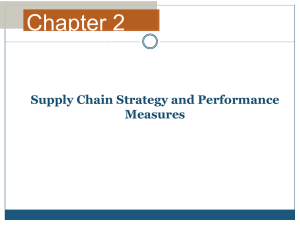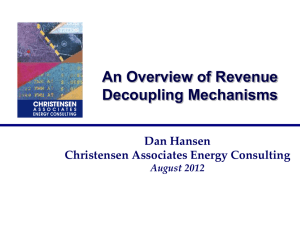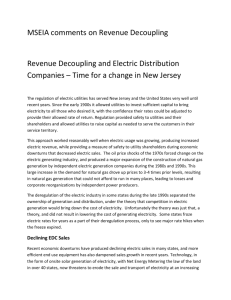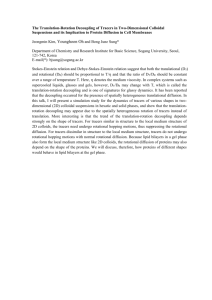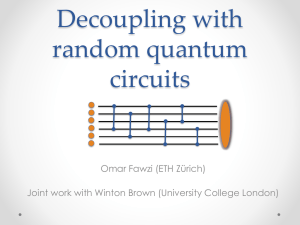100% decoupling - Green Innovations
advertisement
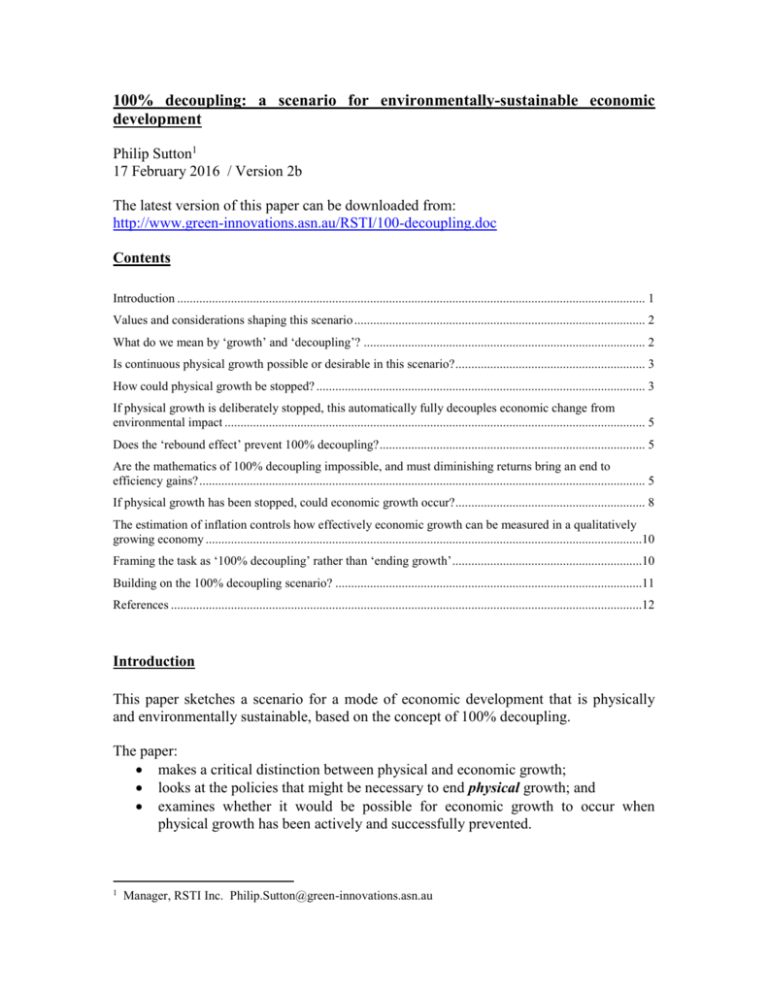
100% decoupling: a scenario for environmentally-sustainable economic development Philip Sutton1 17 February 2016 / Version 2b The latest version of this paper can be downloaded from: http://www.green-innovations.asn.au/RSTI/100-decoupling.doc Contents Introduction .................................................................................................................................................... 1 Values and considerations shaping this scenario ............................................................................................ 2 What do we mean by ‘growth’ and ‘decoupling’? ......................................................................................... 2 Is continuous physical growth possible or desirable in this scenario? ............................................................ 3 How could physical growth be stopped? ........................................................................................................ 3 If physical growth is deliberately stopped, this automatically fully decouples economic change from environmental impact ..................................................................................................................................... 5 Does the ‘rebound effect’ prevent 100% decoupling? .................................................................................... 5 Are the mathematics of 100% decoupling impossible, and must diminishing returns bring an end to efficiency gains? ............................................................................................................................................. 5 If physical growth has been stopped, could economic growth occur?............................................................ 8 The estimation of inflation controls how effectively economic growth can be measured in a qualitatively growing economy ..........................................................................................................................................10 Framing the task as ‘100% decoupling’ rather than ‘ending growth’ ............................................................10 Building on the 100% decoupling scenario? .................................................................................................11 References .....................................................................................................................................................12 Introduction This paper sketches a scenario for a mode of economic development that is physically and environmentally sustainable, based on the concept of 100% decoupling. The paper: makes a critical distinction between physical and economic growth; looks at the policies that might be necessary to end physical growth; and examines whether it would be possible for economic growth to occur when physical growth has been actively and successfully prevented. 1 Manager, RSTI Inc. Philip.Sutton@green-innovations.asn.au Values and considerations shaping this scenario This scenario is shaped by its internal value system and logic. In the scenario the high-order goals of society are taken to be: sustainability for all species of life, ensuring human wellbeing, and for the compassionate, ensuring the wellbeing of all other sentient creatures as well. In this scenario, economic growth is never used as a high order social goal – this would be as useful (or useless) as making ‘speed’ the prime goal of a transport system. The scenario itself includes a reconceptualised analytical framework driven by the scenario goals. What do we mean by ‘growth’ and ‘decoupling’? To be successful in delivering a mode of economic development that is physically and environmentally sustainable it is essential to make a clear distinction between: physical growth, and economic growth. Physical growth is growth in: the quantity of materials, energy and lands/waters used to support the economy, and the physical side-effects (pollution, habitat destruction, etc.) Whereas, economic growth is (uninflated) growth in the economic value2 of the output of the economy. Because of the lived-experience since the beginning of the industrial revolution, there is now a tendency to automatically assume that ‘growth’ means continuous exponential growth. However, mathematically, growth could take many other forms (eg. linear or non-continuous/sporadic or a mixture of forms). Decoupling of economic growth3 from environmental impact occurs when growth in the economy of x% produces less than x% increase in environmental damage4. Absolute or 100% decoupling occurs when x% growth in the economy produces 0% increase in environmental damage or resource depletion. 2 3 4 Essentially the aggregate economic output expressed in terms of monetary exchange value. Or more generally, economic change. eg. environmental harm or resource depletion. Is continuous physical growth possible or desirable in this scenario? In this scenario it is held that the perpetual exponential physical growth of the economy, on a finite planet, is not desirable because of increasingly severe side-effects, and is ultimately physically impossible. From the experience of the last 250 years it seems like the limits that cut in first are the ones driven by the environmental side-effects of the use of materials and energy and the depletion of biological resources. Then there are the limits set by the depletion of high grade minerals. With a severe global crisis of environmental sustainability now unfolding, there is increasing recognition, given expression in this scenario, that the physical growth of the economy must be stopped and in fact the physical scale of the economy needs to be substantially wound back to make the impacts (side-effects) of the economy on the environment bearable and sustainable. (Weaver, et al., 2000) And there is increasing evidence that physical supply constraints are causing a slowdown in rates of production, perhaps even a peaking in total production, of certain physical resources (fish, forests, oil, etc.) How could physical growth be stopped? One simplistic method for ending physical growth would be to freeze the economy in its current physical form. As things wore out they would be replaced with a physical replica but otherwise things would not change. A physically frozen economy would need to have a stable population. And this strategy would end all innovation5 in the physical structure of the economy and lifestyle. But since the macro-environmental impact of the economy is already far too high, the physical scale and impact of the economy needs to be wound back. So a simple physical freeze would not be desirable, even from an environmental point of view. To achieve the wind back in the physical scale and impact of the economy, there would have to be a period of massive innovation to create a physically sustainable economy, that could support the world population without locking people into poverty, and then perhaps the economy and population numbers could be frozen. But if a physically sustainable economy can be created through a period of innovation, wouldn’t it be unnecessarily and in fact undesirably restrictive to then call a halt to all innovation in the physical economy for all time? Some people define the term ‘innovation’ tightly to mean: the application of inventions in the real world (not the process of invention). If this is how you read the word innovation, please note that when I use the term I am assuming that there will be a prior process of invention as well. 5 If we look at a scenario where ongoing innovation in the physical economy is permitted how could environmental sustainability be assured through time? To achieve this, an alternative strategy for ending perpetual exponential physical growth could be used, that is, to define the macro-environmental limits to the economy and to convert these limits into economic policies that successfully shape the macro-economy to achieve the desired macro-environmental outcomes. Let’s try to imagine what this might this look like. The habitat requirements of non-human species would need to be worked out, taking into account long-term needs of species and ecological communities. Environmental conditions vary naturally over time, so habitat requirements would need to take into account long-term resilience. If non-human species are to be sustained then humans will probably have to eventually relinquish quite a lot of land and littoral areas and the harvesting and pollution pressure on the oceans will need to be wound back dramatically. New food production methods will need to be developed that are much more productive per unit of land or harvest area of the ocean. The total food production capacity will set the macro-environmental or macro-economic limit to human population. Improved systems for human settlements will also need to be developed so that the human population can accommodate the habitat needs of other species. The materials and energy economy will need to transition to a physically sustainable structure. In natural ecosystems recycling rates are exceptionally high – over 98%. Ecosystems ‘pay’ for the recycling with energy from photosynthesis (eg. as part of a symbiotic relationship plants feed energy rich molecules to the mycorrhiza that in turn break down the lowest quality biological wastes). So the exceptionally high rates of recycling in nature ecosystems do not violate the laws of thermodynamics. It is likely that extremely high recycling rates evolved in natural ecosystems because this maximised the amount of material that was available to support living biomass and because it prevented the build up of toxic substances. A human economy that was not physically growing would similarly find that human wellbeing could be maximised by aiming for as close as possible to 100% recycling of materials. For the same reason extremely high efficiency of energy use would be favoured. Since energy can’t be endlessly recycled (which is why perpetual motion machines are physically impossible) a physically sustainable human economy would need to rely on the flux of solar energy6. Habitat needs would set a limit to how much of the earth’s 6 And perhaps geothermal energy. surface could be devoted to the capture of solar-sourced energy and this would therefore put a limit on the total amount of energy available to the human economy. The management of the economy would be restructured to physically shrink it to a sustainable level and to prevent subsequent physical growth using a new mixture of laws (macro-regulations), prices, investments and cultural practices. If physical growth is deliberately stopped, this automatically fully decouples economic change from environmental impact If macro-environmental / macro-economic controls are put in place to end the physical growth of the economy, then, everything else being equal, when innovation in production occurs it would be possible for use value to grow in aggregate without that causing increased impact on the environment or increased resource depletion. This means that the economy is automatically 100% decoupled by the action of stopping the physical growth of the economy. Does the ‘rebound effect’ prevent 100% decoupling? It is often argued that the rebound effect7 prevents the achievement of 100% decoupling. In a physically unconstrained economy, efficiency gains in material or energy use, when accompanied by money cost reductions, are often substantially offset by increased purchases, enabled by the cost savings, thus leading to additional use of materials and energy that partly offsets or perhaps more than offsets the original efficiency gains. Everything else being equal, if the total purchasing power of an economy grows then improvements in the material/environmental efficiency8 of production, use and disposal of individual products are likely to be accompanied by increased aggregate resource use and environmental impact. But this effect can only occur in a physically unconstrained economy. It is precisely the macro-environmental/macro-economic controls that create the 100% decoupled economy that bring an end to the rebound effect. Are the mathematics of 100% decoupling impossible, and must diminishing returns bring an end to efficiency gains? Some people, in exploring the maths of decoupling, conclude that they are impossible. They start with an exponential rate of economic development and then show the ‘impossible’ growth in the level of material efficiency of the economy that must occur if 100% decoupling is to be achieved. 7 8 Also known as the Jevons paradox. Eco-efficiency. For example, if the exponential economic growth rate was 5% per annum then to maintain 100% decoupling, the material efficiency of the economy would have to also improve by 5% per annum. In this example economic growth and the material efficiency of the economy would both double about every 14 years, and the economy would be twice as efficient in 14 years, 4 times as efficient in 28 years, 8 times as efficient in 42 years, 16 times as efficient in 56 years, 256 times as efficient in 112 years, and 32768 times as efficient in 210 years, and so on into the future. Surely such extraordinary increases in the material efficiency of the economy cannot be physically possible? This approach to posing and analysing the problem confuses the decoupling issue in several ways. Firstly, the most effective way to achieve 100% decoupling is to cap the material size of the economy. Then if any economic growth does occur, it must be 100% decoupled because the economy cannot grow physically. If an economy happened to achieve long term average GDP growth over 50 or 100 years, this would not create impossible mathematics (for physical efficiency improvement) because the GDP growth could not have happened if the relevant efficiency improvement hadn’t actually occurred in the real world. The question in this context is: could such a rate of economic growth actually occur in the real world in an economy that is not growing physically? Are there insurmountable ‘diminishing returns’? The second source of confusion arises from an unconscious misinterpretation of the definition of material efficiency. Most people understand material efficiency as an engineering concept. For example, how efficient is this mining process? (eg. how much rock has to be dug up to make how many ingots of copper?) How efficient is this power station? (eg. how many tonnes of coal have to be used to generate a kilowatts hour of electricity?) For any physical process where there is limited scope for miniaturisation there will almost certainly be diminishing returns for investment in improvements in the engineering type of material efficiency improvement – due to thermodynamic limits. But when the measure being considered is the material efficiency of the output of economic value, this is a very different concept and it will frequently have very different dynamics. When a whole economy has had its physical scale capped, then more and more economic production will be distinguished by its quality (rather than physical quantities) and often the knowledge intensiveness of production and products and services. Products and production processes that are knowledge intensive can often allow huge and long lasting scope for miniaturisation, which means that physically imposed diminishing returns on investment might be avoided for a very long time9. 9 eg. the miniaturisation of computers. Insights into the issue of diminishing returns can be gleaned from the study of the history of technology and innovation and even from the field of biological evolution. Innovations rest on the creation of new possibilities and these cannot be guaranteed to appear on demand. A pattern is often noticed that once a major breakthrough-innovation occurs, it creates a disruptive wave of change that then leads fairly quickly to a cascade of further innovations in response to the new situation. Then, it is usually the case that the rate of innovation tails off as the network of changes surrounding the big breakthrough innovation matures (the law of diminishing returns). The innovation rate in the ‘diminishing returns period’ might just become lower than before or it might perhaps go to nearly zero, until some new disruptive innovation is invented which then sets off a new fast wave of innovation10. But over a whole economy it is probabilistically likely that when the innovations rates of each of the myriad segments of the economy are averaged, at least a certain minimum level of innovation will occur each year (that is, it is quite unlikely that there will be any years in which there would be no innovation. And in innovative societies that have policies in place to reliably end physical growth, it would, most likely, still be rare to have years in which use value growth did not also coincide with at least maintained levels of labour productivity. If aggregate hours worked are maintained then this combination (innovation plus maintenance of labour productivity and total hours worked) will normally result in economic growth. Since, as yet, no industrial society has adopted a policy of systematically ending physical growth, we can only speculate on which of the following such a society would experience in reality: a complete cessation of economic growth (my guess is that this is unlikely unless innovations is consciously stamped out of the society); or linear economic growth (not exponential); or episodic economic growth; or exponential economic growth but at a low rate; or exponential economic growth but at a higher rate. The actual outcome probably depends a lot on the innovation polices that each society chooses to pursue. But if you think that innovation would eventually come to a halt in an economy that is not physically growing, just keep in mind that biological evolution has not stopped in the 3.5 billion years that life has been on the earth – despite the flow of solar energy and the size of the earth being essentially the same over that whole time. 10 In biological evolution, this phenomenon is called ‘punctuated evolution’. If physical growth has been stopped, could economic growth occur? Many people think that physical growth and economic growth are the same thing or, if not the same thing, then they are so closely causatively linked that economic growth must lead to physical growth. As discussed above physical growth and economic growth are not the same type of thing at all. However, over the last several hundred years, the scale and pattern of growth of both types have been very strongly correlated – which is why the belief that economic growth must cause physical growth has developed. This belief is reinforced at the level of everyday experience. Since all goods and services in the economy are manifested in the physical world11, people often conclude that growth in the value of goods and services must increase the demand for physical resources (land, waters, materials and energy). But there are circumstances in which aggregate growth in the output of economic value can occur when the physical growth of the economy has ceased. Both goods and services can be conceptualised as “a flow of use value enabled by a physical platform”. If the goods and services are sold then they are transferred at their exchange value. So a jar is “containment value” enabled by “glass” sold for $x, and a medical check up is “diagnosis value” enabled by “a doctor physically kitted out in their clinic” and sold for $y. If the physical growth of the economy has been deliberately stopped but innovation continues then improvements in the total use value can occur in three conceptually different ways: even if the physical platform for goods or services remains quantitatively the same, the design of a good or service can be improved to increase the flow of use value; or even if the use value remains the same, the delivery platform can be redesigned so that the physical footprint is reduced thus allowing for the production of additional goods or services (without violating the overall physical limits on the economy); or while keeping within the overall physical limits on the economy, the mix of goods and services can be changed so that improved synergy increases the flow of use value. Of course all three modes of innovation can be combined. Eg. even ‘disembodied’ data flowing through the internet requires a physical infrastructure and energy to carry it and process it. Similarly, singing for a living requires a physical world to nurture the singer and the audience. 11 Everything else being equal, innovation to increase the use value of goods and services might not translate into economic growth if the labour hours required to produce the revised basket of goods and services increases. But, everything else being equal, if the labour intensity of total production remains the same or falls, increases in the production of use value will create the statistical outcome recognised by economists as economic growth. If the following two types of innovation are combined then economic growth is possible in an environmentally sustainable economy in which physical growth has been consciously and fully stopped: 1. innovation to increase the ratio of total use value to total material footprint (ecoefficiency innovation); and 2. innovation to increase the average labour productivity per unit of production (labour efficiency innovation). How much scope is there for eco-efficiency innovation? In the 1990s a group of Dutch government agencies supported a major project undertaken by academic and industry researchers to see if type 1 innovation could be ramped up massively. Their studies showed opportunities to boost eco-efficiency per unit of production by between factor 20 (95%) and factor 50 (98%) depending on the economic sector under examination (Weaver et al. 2000). The research team’s qualitative assessment was that the opportunities for eco-efficiency improvement would not decrease labour productivity and most likely would increase it (type 2 innovation). While reiterating the point made earlier that economic growth should never be made the primary or a dominant goal of society12, are there any conditions under which economic growth could perhaps occur, in the long term, once the physical growth of the economy has stopped? If labour productivity grows systematically over the long term (driven for instance by a growing knowledge base, very high skills, creativity and sophisticated supporting technology), more than compensating for any reduction in totals hours worked; and If miniaturisation of physical systems continues for the very long term (especially for those systems that have the greatest bearing on labour productivity growth) Then, it is conceivable that some level of economic growth could continue over the very long term in an economy that has stopped physical growth. 12 Ending poverty is a good goal and this might require expanded production of physical goods for a period in some places. But this can be accompanied by extremely high levels of materials recycling and other strong eco-efficiency measures so this increased production might be able to occur within a global economy that is physically capped. The estimation of inflation controls how effectively economic growth can be measured in a qualitatively growing economy It is only possible to say whether an economy has grown or not if price inflation or deflation can be stripped from the accounts. If from one time period to another the price of an identical good or service goes up one can say that it has experienced price inflation. But what conclusion should be drawn if a class of goods in the market is replaced by a somewhat similar class of goods for a higher price. If the new class of goods is superior to the old class of goods then perhaps the increased price is not due to inflation but is a reflection of the improvement in the class of goods. When the quantities of goods or services change in the economy, but the qualities do not, then it is relatively straightforward to calculate inflation. But when quantities are not changing much but products (or their substitutes) evolve qualitatively it is harder to estimate inflation. This then makes the economic growth figures more subjective and it also makes it harder to estimate labour productivity. Framing the task as ‘100% decoupling’ rather than ‘ending growth’ Does it matter what labels we attach to our policies? Aren’t we going to deploy the same policies to pull back from environmental catastrophe whether we call for the end of physical growth or for decoupling? Professor Tim Jackson, author of Prosperity without Growth and Herman Daly, the grandparent of the macro-economics of the environment talk about ending economic growth but their practical implementation measures are quite similar in many respects to the measures that I outlined above. Why then advocate ‘100% decoupling’ instead? Social policy has been badly distorted by society’s growth fetish. Pro-growth fetishists, on the one hand, distort society by taking our minds off what the economy should really be for: enabling sustainability and wellbeing. And many anti-growth fetishists, on the other hand, confuse our understanding of the critical difference between physical and economic growth and as a consequence they often identify investment and innovation (‘too much’ of both) as being key causes of our environmental crises, whereas, in the appropriate environmental policy setting, innovation and investment are vital tools for creating and maintaining a sustainable world that nurtures the wellbeing of people and other life. The rhetorical frames of ‘ending economic growth’ and ‘100% decoupling’ have very different effects on the various sectors of society and so the choice of frame can be enormously important. Over the last four decades, many issue concerns have been realigned. Whereas 40 years ago environmental concern was not strongly polarised on the left-right spectrum, now the polarisation is very strong and getting stronger in at least the US, Canada and Australia. In those countries most people now assume that people who care about the environment are “left leaning’. Over the same 40 years the severity of many environmental problems has ramped up to severe levels, and will get even worse, with the result that some problems like climate change are now threatening the viability of human society and the survival of probably most other species. The physical action needed now to solve the climate problem is of such a huge scale and must be delivered so rapidly that it will only be achievable through a wartime-intensity economic mobilisation.13 But wartime-intensity mobilisations are only possible when there is very considerable social unity across the political spectrum. So for as long as it is assumed that strong action on environment is a left-wing issue it will be easy to mobilise people on the right to oppose effective action. This dynamic is very evident in the US, Canada and Australia. Many people, not only on the right of politics, see efforts to end economic growth as a threat to innovation, competition, creativity and social improvement. A world like this is not one they want and this makes the siren song of environmental denialism very compelling. As long as we argue that environmental problems can only be solved by ending economic growth we will guarantee that our efforts will fail to reach the level of support needed to be effective – because the ‘end economic growth’ strategy is seen to be anti-innovation. The 100% decoupling approach produces the same positive environmental outcome that is expected to come under an ‘end economic growth’ framing, but it differs in placing a strong emphasis on the continuing need for innovation and investment. This framing has a very good chance of uniting people across most of the political spectrum. With a ‘100% decoupling’ framing there is a possibility that we might be able to achieve ecologically sustainability, in time. With an ‘end economic growth’ framing we certainly won’t. Building on the 100% decoupling scenario? At the moment the positions on growth and decoupling that are best developed are: business-as-usual views (ie. economic and physical growth is good and we need some add on environmental management) 13 See: http://www.green-innovations.asn.au/RSTI/A-safe-climate-is-still-possible.doc end-economic-growth views (ie. economic growth is an intrinsic problem and needs to be stopped in favour of a steady state economy) partial-decoupling views (ie. economic growth and physical impact need to be decoupled to a large degree but 100% decoupling is too hard/impossible). The idea of 100% (or absolute) decoupling is not widely known by the public and by economics elites. And while this is so, no society will be able to make 100% decoupling a key underpinning of their economy. So a useful next step would be to create a project to articulate the 100% decoupling concept and to spell it out as an implementable program. Please contact me if this interests you. Philip.Sutton@green-innovations.asn.au Tel: +61 3 9078 9746 References Weaver, P., Jansen, L., van Grootveld, G., van Spiegel, E. & Vergragt, P. (2000). Sustainable technology development. Greenleaf Publishing: Sheffield, UK.


